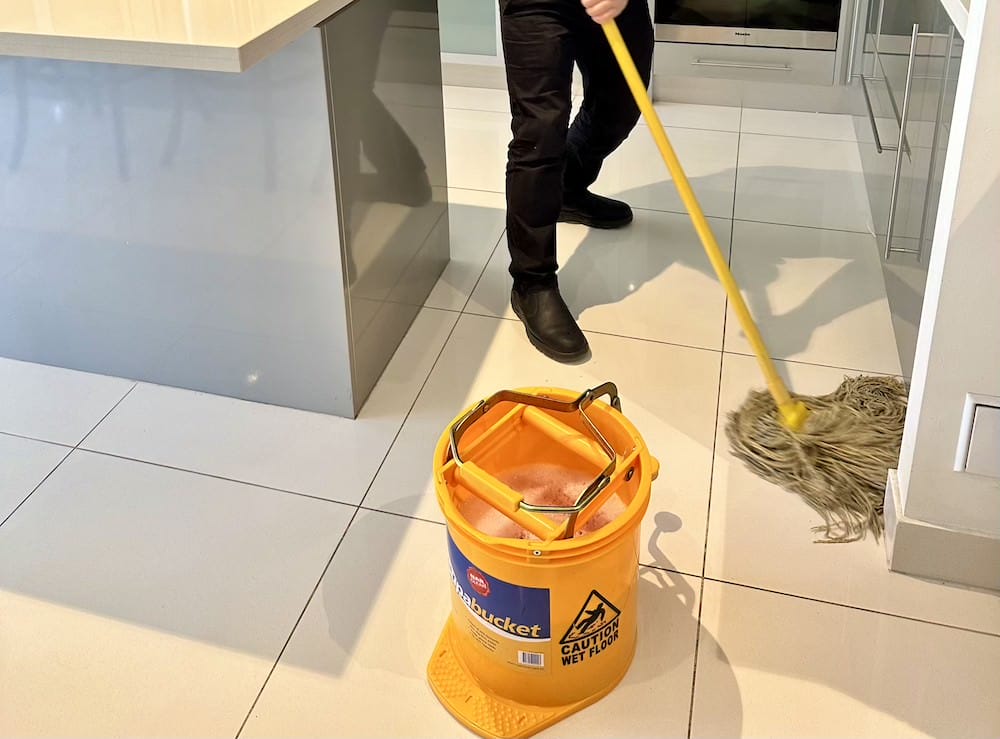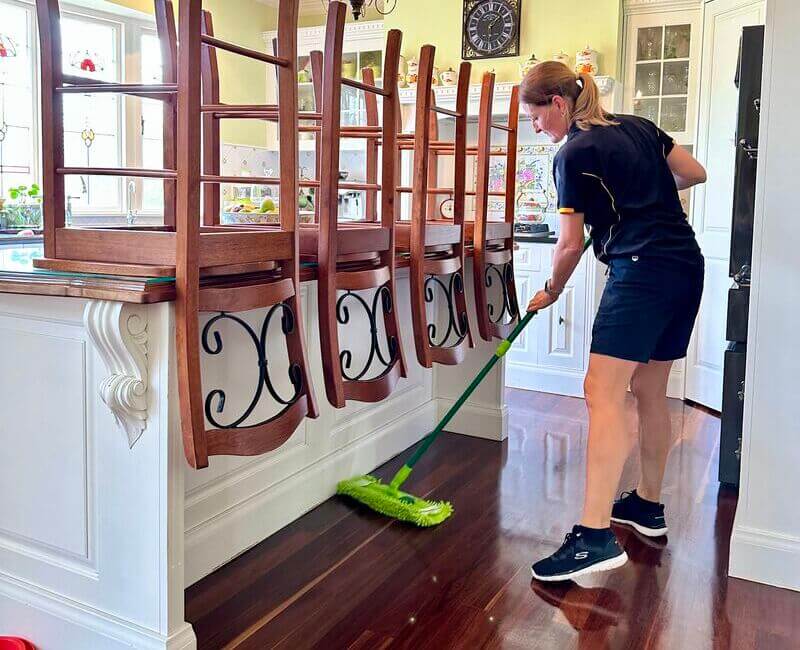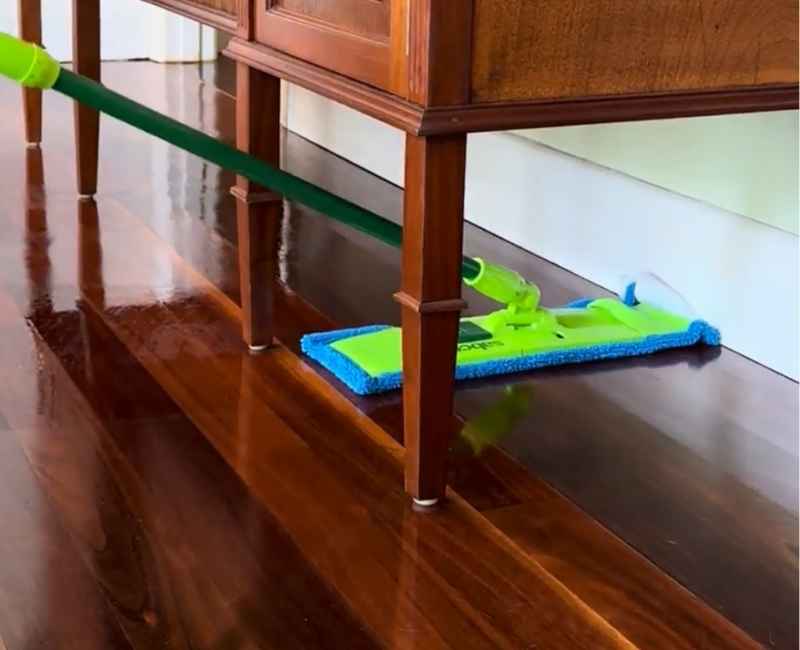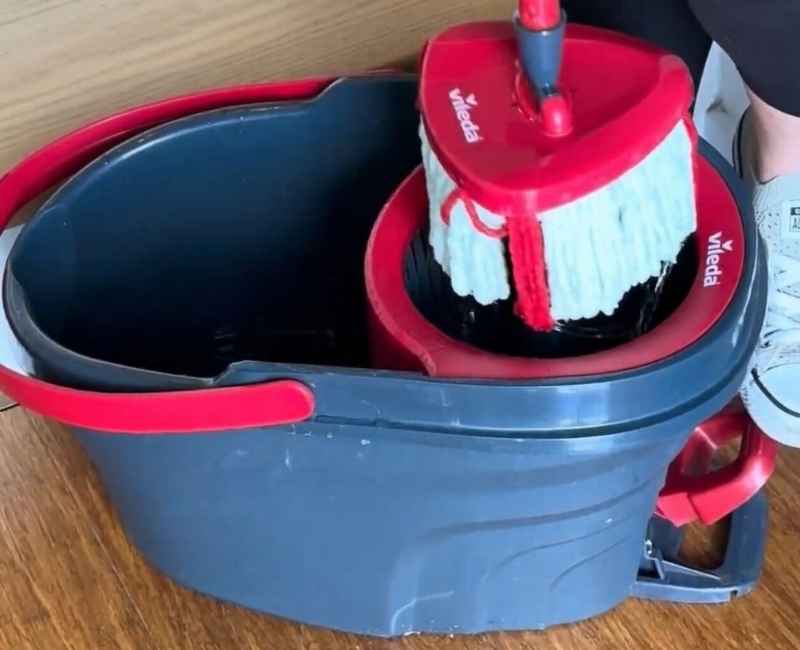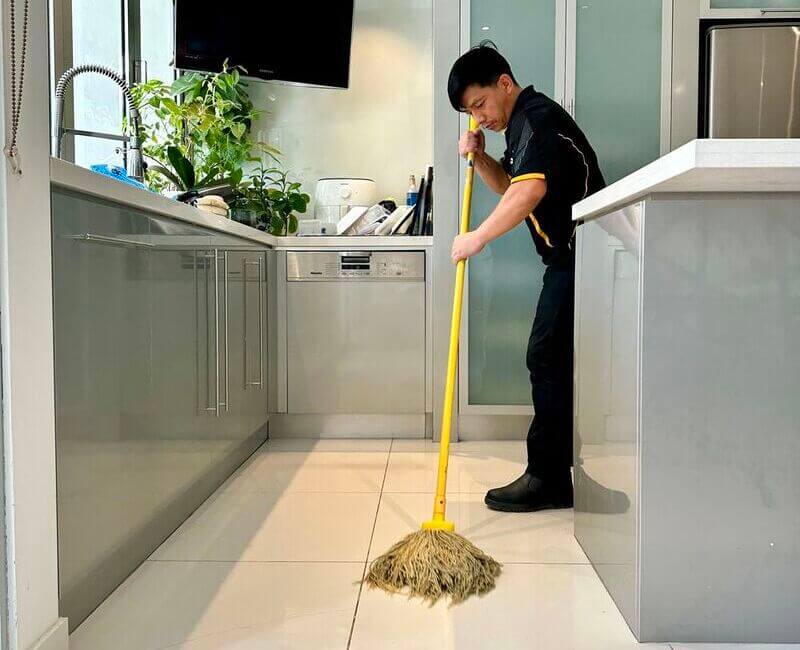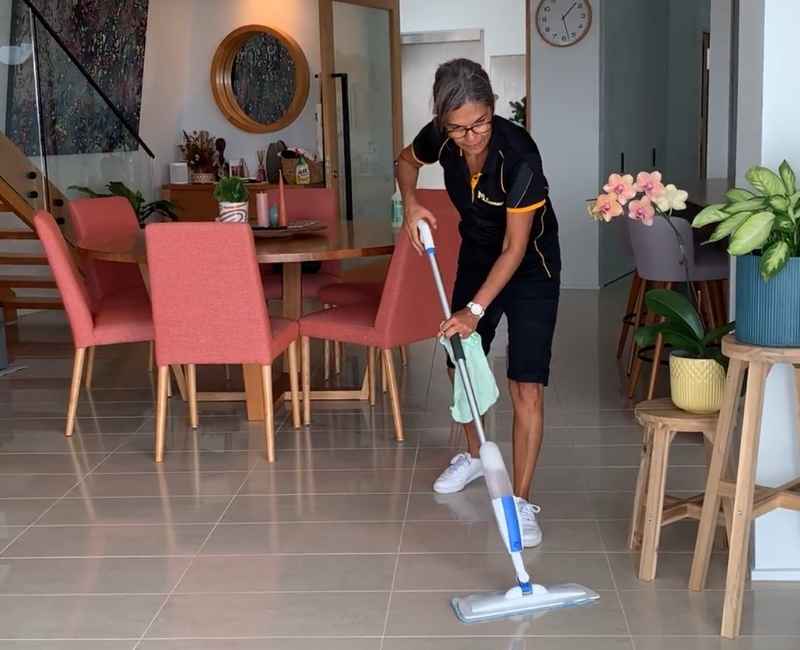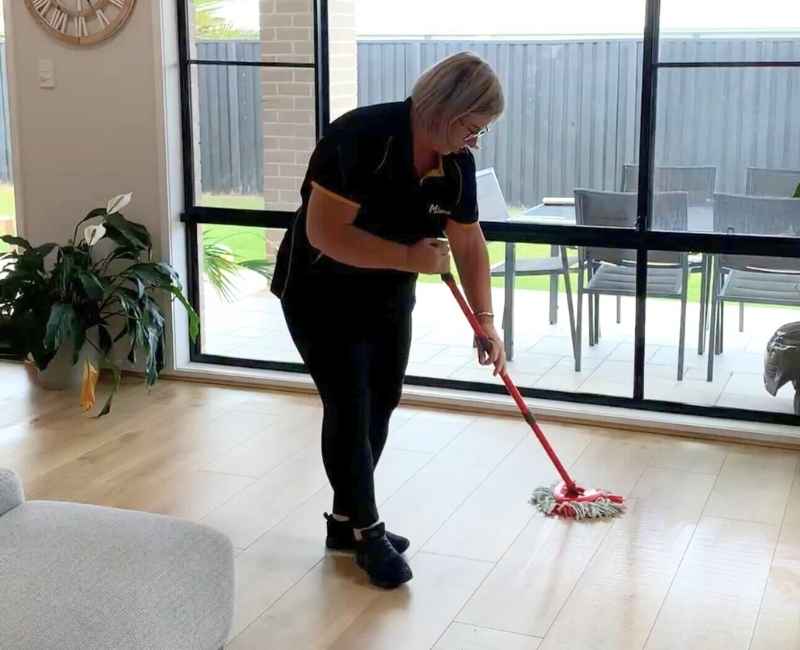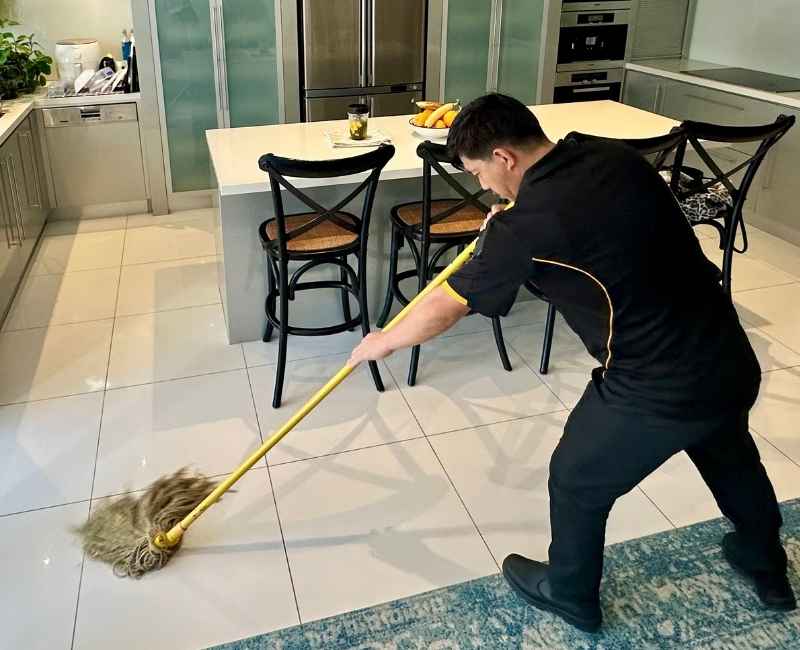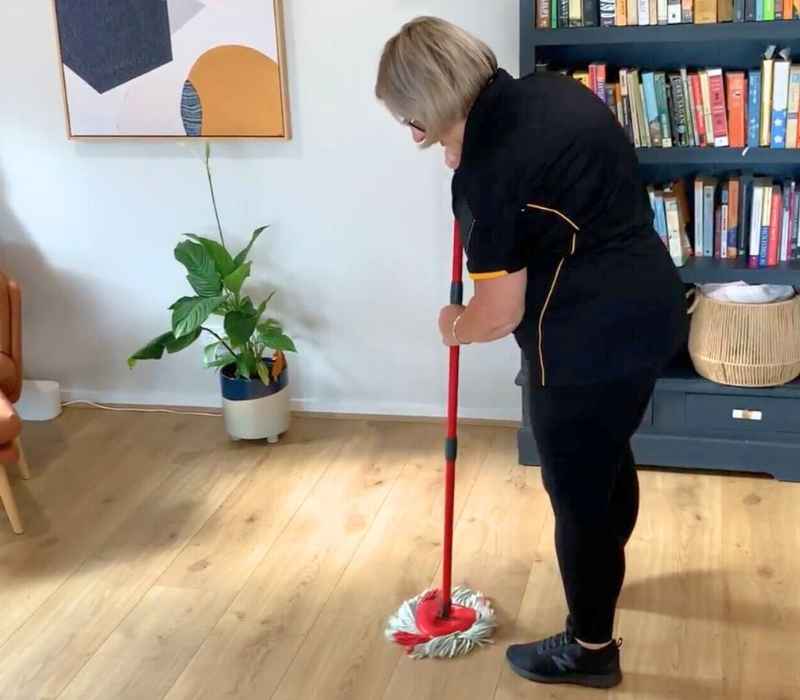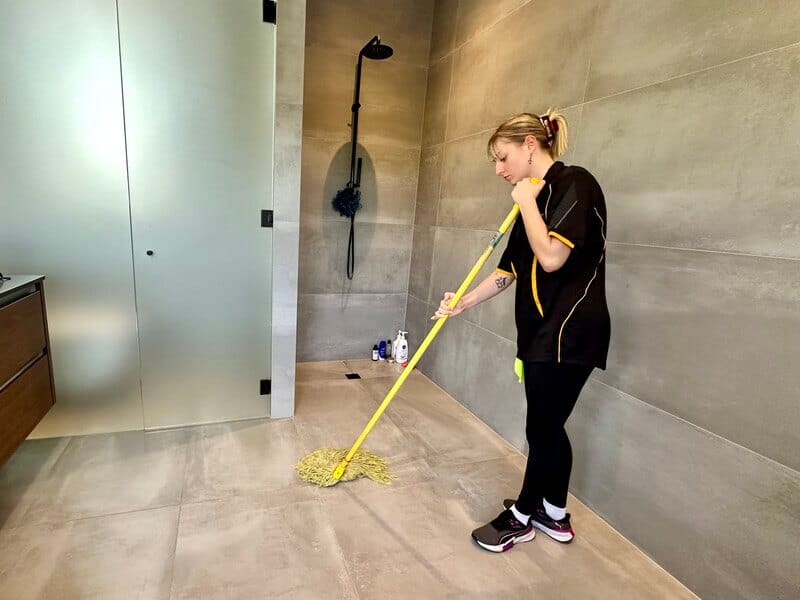Did you know that the way you mop your floors can make a big difference in how often they need to be cleaned?
Mopping floor surfaces is often the best option for deep cleaning. It’s quick, efficient, and gets the job done — plus with the right tools and techniques, you can make mopping easy and enjoyable.
Knowing how to mop different types of flooring correctly will keep your floors clean and help them last longer. Grab your weapon (mop) of choice — it’s time to become the Mop Master!
How Often to Mop | What to Mop With | How to Use A Mop | Mopping Different Types of Floors | After Mopping
Types of Mops
The mop you use can make or break your mopping experience! Getting the best quality mop suited to your floors will ensure a thorough clean.
Generally, you’ll get four different types of mops, each with its “best uses.”
Dust mop
A dust mop is typically made of a cloth or similar soft material. They’re used alongside brooms for sweeping floors before mopping, since they collect dust, dirt, and debris.
They’re especially good for hardwood floors, since there’s less risk of scuffs or scratches compared to vacuums.
You can also use a dust mop to clean the walls and ceilings. In these situations, mops are usually equipped with an extension handle to reach high areas.
Note that dust mops are meant to be used dry, so don’t add any water or product!
Flat mop
A flat mop has a wide piece of absorbent fabric or sponge (also called a sponge mop) at the end of a long handle. When you drag the mop head across the surface, it absorbs dirt and grime.
Older flat mops were made from cotton or other natural fibres, but modern ones are usually made of microfibre, which is more effective at absorbing water and trapping dirt.
This type of mop is often used with a bucket and wringing mechanism. This lets you repeatedly dip the mop head in clean water and wring it out, ensuring it remains damp but not wet.
Spin mop
As the name suggests, spin mops have a spinning mechanism built into the bucket, which wrings out the mop head. This allows you to use less water when mopping and prevents streaking or soaking.
Spin mops are easier to use than traditional flat or string mops, since they require less effort to wring out the mop head. They’re also lightweight and simpler to manoeuvre.
Many mops come with a removable head that you can change if it becomes too dirty.
String mop
These are the most “traditional” mops, with a head of absorbent material (like cotton fibres) attached to a handle. The head is typically rectangular, with the strings on one side.
String mops tend to leave more water on a surface than other types.
How Often Should You Mop Your Floors?
A good general rule is to vacuum and mop your floors once a week. This keeps your floors looking their best and prevents a buildup of dirt and grime.
Regular mopping also gives you a chance to check for any wear and tear, such as cracked tiles or warped floorboards.
If you have pets or small children, or have very high traffic areas, it’s better to vacuum and mop at least twice a week. You should also mop more frequently if someone has allergies, as it minimises irritants.
And hey, if it feels like a never-ending battle with your floors, you can pass the baton — or rather, the mop — to one of Maid2Match’s professional house cleaners.
What to Mop Floors With
The best solution for mopping floors will depend on the type of floor you’re cleaning! Different materials have different cleaners.
It’s important to use the appropriate cleaner, or you could end up with sticky floors after mopping — or worse, a damaged floor.
Here are some recommended floor cleaners from our cleaning pros:
- Hardwood floors: pH-neutral wood cleaner
- Laminate floors: Mild soap or water-based cleaner
- Tile floors: Mild soap or a good tile cleaner
- Vinyl floors: Diluted white vinegar or floor cleaner
When using commercial cleaners, follow the instructions for dilution. More product doesn’t mean more cleaning — in fact, it can make your floors gummy, dingy, or streaky instead.
Avoid using “mop and shine” products, especially on no-wax vinyl or hardwood. These can leave a residue that builds up and ruins the finish of your floors.
Do not use harsh chemicals like bleach or highly abrasive products, which could damage the floor material.
Using Different Types of Mops
No matter what mop you have, the physical act of mopping is similar — keep the head flat against the floor, then move the mop back and forth.
Still, there are ways to make the most out of each type of mop!
How to use a dust mop
Dust mopping is the same as dry mopping! The process helps remove dust and small debris like pet hair or dander, which might not be picked up by a broom.
To dry mop a floor, start with a clean and dry mop head. Move small pieces of furniture and any rugs or mats out of the way.
Begin mopping from one corner of the room, keeping the mat as flat as possible on the floor. Make one long pass from one end to the other, overlapping slightly each time.
When the head gets too dirty, shake off the dust into the rubbish bin or replace it with a clean one. Keep going until you’ve covered the whole floor.
Sweep any piled-up debris or use a handheld vacuum.
How to use a flat mop
Flat mops are pretty straightforward — you’ll need two buckets, one for your cleaning solution and one for clean water.
Dunk your sponge mop into the cleaner and wring or squeeze out any excess liquid. Mop in small sections using straight-line strokes.
Rinse the mop head frequently as you make your way across the floor. When you’re done, wash out any residue from the mop and go over the floors with plain water.
How to use a spin mop
Some spin mops come with a two-part bucket — a reservoir for water and a raised spinning mechanism. Others have the spinner built inside the bucket.
Fill the reservoir with water and your chosen cleaning solution. Soak the mop head, then move it to the spinner and pump the handle a few times to wring out excess water.
For mops with a single bucket, you’ll need to spin the mop a few times to saturate the fibres. Then quickly raise the mop to lift the spinner out of the water so you can wring out excess moisture.
Mop in a back-and-forth or figure-8 motion, keeping the head flat to the floor. Rinse the mop in clean water every so often to remove dirt. Repeat the process until the floor is clean.
Once you’ve finished mopping, empty the dirty water from the reservoir and rinse the mop head. Allow everything to air dry completely before storing.
How to use a string mop
Fill one mop bucket with your cleaning solution and another with plain water for rinsing.
Dip the string mop head into the cleaner, then wring out the excess. Move the mop in a figure-8 motion, swirling back and forth.
Rinse the mop every so often, then dunk it into the cleaner again. Once you’ve finished, rinse the mop again, then go over the floors with plain water to remove any residue.
Detach the mop head and wash it after using, then place it in a well-ventilated area to air dry.
How to Mop a Floor (By Types of Flooring)
Before you start mopping, sweep or vacuum the floors! This way, you’re not pushing loose dirt around, which could potentially scuff your floors or seep into the material.
Move the furniture aside so you have access to the entire floor. Then prep your cleaning materials, especially if you’ll need a separate cleaning solution and rinse bucket.
To mop properly, start from the corner of the room that’s furthest from the door, then work your way backwards. This way, you don’t accidentally track dirt onto already-cleaned areas.
How to mop hardwood floors
You should only damp mop wooden floors — never wet mop! Too much water can damage the finish or soak into the floorboards, leading to mould or warping.
Sponge or microfibre mops are best for hardwood, since string mops can leave excess moisture and streaks.
To clean hardwood or timber floors, follow the instructions on your wood floor cleaner. Dilute the product in the correct amount of water if necessary.
After dipping the mop into your cleaning solution, wring out the excess water so it’s just damp.
Start mopping in small sections with a back-and-forth motion. Rinse the mop head every so often, then dip it back into the cleaner. Repeat until the floor is clean.
Dry the floor immediately with a clean mop or some old towels to prevent water spots.
How to mop laminate floors
It’s best to dry or damp mop laminate floors, as exposure to excess moisture can cause the material to swell or warp.
To clean laminate floors, mix a small amount of mild dish soap with warm water in a mop bucket. Dip the mop head into the solution, then wring it out so it’s just damp — use as little water as possible.
Use gentle strokes to mop the floor, working one small section at a time. Avoid using too much pressure, which could push the soapy water into the material or damage the floor.
After mopping, rinse the floor with plain warm water, then dry it immediately with a clean mop or old towels.
How to mop tile floors
Porcelain and ceramic tile floors are both very forgiving and durable! To mop tiles, use a good tile cleaner or mix half a cup of vinegar with 3 litres of warm water.
Stone tiles will need a dedicated stone cleaner so you don’t etch or discolour the material.
It’s best to use a microfibre mop pad when cleaning tiles, since it minimises the water pushed into the grout lines.
Follow the dilution instructions of your chosen tile cleaner. Use one bucket for the cleaning solution and a separate one for rinse water.
Start mopping in one corner and work in small sections, with gentle, even strokes. Rinse the mop regularly so you don’t leave streaks.
Once a month, you’ll also need to deep clean the tile grout after mopping your tiles! You can scrub the grout with some soapy water and an old toothbrush, or use an appropriate tile grout cleaner.
How to mop vinyl floors
Vinyl floors are fairly easy to clean! Your best bet is a flat or sponge mop, which moves easily over the smooth surface.
Most vinyl floors can be cleaned with diluted white vinegar, but check with the manufacturer first. Otherwise, use a vinyl-safe cleaner (even a multi-purpose cleaner will work).
To mop vinyl plank floors, mix one cup of white vinegar or apple cider vinegar per 3 litres of warm water. Dip the mop head into the solution, then wring it out so it’s just damp.
Mop the floor in even strokes, going in the direction of the vinyl “grain” so you don’t leave streaks. Rinse the mop frequently.
When you’re done, go over the floors with a dry mop or old towels to dry.
What to Do After Mopping
For hardwood, laminate, and vinyl, it’s best to go over the clean floors with a dry mop to remove excess moisture. The leftover water can seep into the material and cause mould, swelling, or warping.
Keep the room well-ventilated as the floors dry! You can also point an electric fan at the surface to speed things up.
Always wash the mop heads after you’re done cleaning. This prevents a buildup of dirt and grime, and ensures you have a clean mop for next time.
If you can’t wash the mop head right away, give it a good rinse in running water. Make sure it’s completely dry before storing it away.
Don’t forget to wash and dry the buckets, too!
For tough or sticky spots after mopping, mix a little dish soap with hot water in a spray bottle. Spritz it onto the affected area and wait a few minutes before scrubbing with a damp microfibre cloth.
For larger sticky spots, you can damp mop the area (hardwood floors) or clean with a vinegar solution (laminate, tile, vinyl). Mix a cup of white vinegar with 4 litres of warm water, then use that to mop the floor.
More About Mopping the Floor
Got more questions about the mopping and rinsing process? Here are some answers to common concerns.
Do you just use water when mopping?
For a thorough clean, it’s best to mop your floors with water and an appropriate cleaner. This will effectively remove dirt and can help protect the floors between mopping sessions.
Are you supposed to rinse the floor after mopping?
Yes, you should rinse the floor after mopping! Use clean water and a separate mop, if possible, so you’re not tracking dirt back onto the floor.
Rinsing removes any residue from your cleaning solution, which could lead to sticky floors that attract more dirt.
What’s the correct way to handle dirty mop water?
It’s important to dispose of dirty mop water correctly! Your best bet is a floor drain or laundry sink — somewhere that sees plenty of dirty water on a regular basis.
If that’s not an option, you can flush mop water down a toilet or pour it into the tub.
Do not pour dirty water into the kitchen or bathroom sinks, as it can lead to clogs or cause hygiene issues. Avoid disposing of it in the garden, too, as the runoff might harm your plants.

